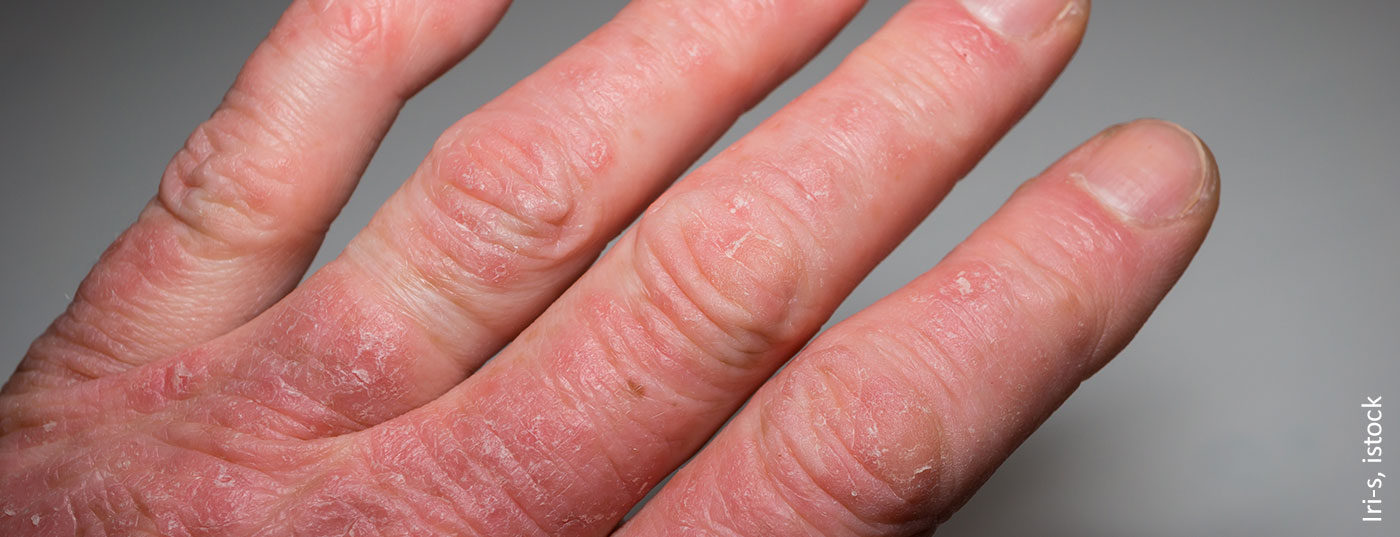Approximately one-third of patients with psoriasis develop psoriatic arthritis (PsA). The events responsible for progression to PsA are still unclear. However, genetic and clinical demographic risk factors, particularly family aggregation and psoriasis sub-phenotypes, provide relevant insights into the variables that promote transition.
Early diagnosis and treatment of PsA is essential for the prevention of structural joint damage and loss of function. As little as a six-month delay from symptom onset to treatment contributes to the development of peripheral joint erosions and deterioration of long-term physical function [2]. However, early PsA diagnosis is a multiple challenge because it is not a straightforward disease entity and, moreover, there is a lack of prognostic biomarkers for disease progression.
If we look at the development of PsA, we can also speak of the psoriasis-PsA continuum. About 80% of patients who develop PsA have psoriasis beforehand. Meanwhile, there is an increase in systemic terminal inflammation. What is unclear about this transition, however, is what exactly happens during it. How is this transition phase characterized and which patients are at increased risk of developing PsA?
Laboratory chemical, imaging, and clinical risk factors.
Key unmet needs in PsA include defining psoriatic patients at increased risk for developing arthritis, improving understanding of the natural history of the disease, and characterizing the immunologic, environmental, and molecular subclinical events that precede the onset of PsA. Dr. David Simon, Rheumatology and Immunology, from the University Hospital Erlangen (D), focused his presentation on the risk profile of patients and the characterization of the transition phase: clinical and epidemiological risk factors may contribute to the development of PsA. Thus, on the one hand, the psoriasis phenotype, but also the severity of psoriasis plays a role. And risk factors such as obesity can also promote PsA.
Studies have shown CXCL10 to be a promising serological biomarker. CXCL10 is a molecule produced by various inflammatory cells such as. lymphocytes and keratinocytes is released and leads to the development of an angiostatic and recruiting effect of inflammatory cells. Serum levels of chemokine (C-X-C motif) ligand 10 (CXCL10) have been found to decrease after the onset of PsA, allowing triggering of PsA. These results support the association of CXCL10 with the development of PsA in patients with psoriasis and warrant further investigation into the predictive ability of this chemokine [3].
Increased osteoproliferation in PsA patients.
Results from the prospective PSARTROS study further demonstrate that increased osteoproliferation occurs in PsA patients. These osteoproliferative changes show a strong correlation with the duration of the disease as well as with the age of the patients [4]. Osteoproliferative changes are structural entheseal lesions (SELs) that occur at the tendon and capsule and thus are found where PsA patients have symptomatic changes. Osteoproliferative changes are also detectable in psoriasis patients without musculoskeletal involvement [4]. To strengthen these findings, a prospective cohort study tested whether the presence of structural enthesis lesions in psoriasis patients influences the risk for progression to PsA. The results show that the presence of structural enthesis lesions and low-cortical volumetric bone mineral density in enthesis segments are associated with an increased risk of developing PsA in patients with psoriasis. SEL is thus another prognostic marker for the development of PsA [6].
In addition to osteoproliferative changes, subclinical inflammation may also pose an increased risk for the development of PsA. The prevalence of subclinical inflammatory lesions is high in patients with cutaneous psoriasis. Arthralgia associated with MRI synovitis even represents a high-risk constellation for the development of PsA [7]. To understand the anatomic basis for joint symptoms in psoriatic patients with arthralgias and the relationship between these imaging findings and subsequent transition to PsA, another study used ultrasound to perform examinations. The results show that synovitis and enthesitis were significantly more frequent in psoriasis patients with and without arthralgias (Fig. 1). Furthermore, psoriasis patients with arthralgias were found to have more frequent subclinical inflammation than psoriasis patients without arthralgias. In addition, evidence of enthesitis was associated with the development of clinical PsA in longitudinal analysis [8].

Radiological effects and inhibition of subclinical inflammation.
A 52-week prospective open-label feasibility study demonstrated regression of peripheral subclinical enthesiopathy in therapy-naive patients treated with ustekinumab for moderate-to-severe chronic plaque psoriasis. Mean inflammation levels decreased significantly during treatment with usekinumab. Within 12 weeks of treatment, inhibition of interleukin(IL)-12/IL-23 in psoriasis appears to suppress subclinical enthesopathy, and suppression is maintained through week 52 [9]. A comparable study was conducted with the anti-interleukin (IL)-17A antibody secukinumab. The results highlight that early disease containment in PsA is possible and leads to a comprehensive reduction in skin symptoms, pain, and subclinical inflammation [10].
In high-risk patients, Dr. Simon concludes, it is worthwhile to use immunomodulatory therapy with cytokine inhibitors. And even in psoriasis patients without this preselection, biologic therapies may reduce the risk of transition to PsA [11].
Take-Home Messages
- Different biomarkers can be helpful in identifying patients at risk for PsA.
- Treatment of subclinical inflammation prevents radiographic progression.
- Biologic therapy in psoriasis patients could reduce the risk of transition to PsA.
Source: Lecture “When does disease begin? Early forms of psoriatic arthritis”, PD Dr. med. David Simon, German Rheumatology Congress 2021, 16.09.2021.
Literature:
- Scher, et al: Preventing psoriatic arthritis: focusing on patients with psoriasis at increased risk of transition. Nat Rev Rheumatol 2019, doi: 10.1038/s41584-019-0175-0.
- Haroon, et al: Diagnostic delay of more than 6 months contributes to poor radiographic and functional outcome in psoriatic arthritis. Ann Rheum Dis 2015, doi: 10.1136/annrheumdis-2013-204858.
- Abji, et al: Declining levels of serum CXCL10 over time are associated with new onset of psoriatic arthritis in patients with psoriasis: A new biomarker? BJD 2020, doi: 10.1111/bjd.18940.
- Kampylafka, et al: Resolution of synovitis and arrest of catabolic and anabolic bone changes in patients with psoriatic arthritis by IL-17A blockade with secukinumab: results from the prospective PSARTROS study. Arthritis Res Ther 2018, doi: 10.1186/s13075-018-1653-5.
- Simon, et al: Analysis of periarticular bone changes in patients with cutaneous psoriasis without associated psoriatic arthritis. Ann Rheum Dis 2016, doi: 10.1136/annrheumdis-2014-206347.
- Simon, et al: Structural entheseal lesions in patients with psoriasis are associated with an increased risk of progression to psoriatic arthritis. Arthritis Rheumatol 2020, doi: 10.1002/art.41239.
- Faustini, et al: Subclinical joint inflammation in patients with psoriasis without concomitant psoriatic arthritis: a cross-sectional and longitudinal analysis. Ann Rheum Dis 2016, doi: 10.1136/annrheumdis-2015-208821.
- Zabotti, et al: Transition phase towards psoriatic arthritis: clinical and ultrasonographic characterisation of psoriatic arthralgia. RMD open 2019, doi: 10.1136/rmdopen-2019-001067.
- Savage, et al: Regression of Peripheral Subclinical Enthesopathy in Therapy-Naive Patients Treated With Ustekinumab for Moderate-to-Severe Chronic Plaque Psoriasis: A Fifty-Two-Week, Prospective, Open-Label Feasibility Study. Arthritis Rheumatol 2019, doi: 10.1002/art.40778.
- Kampylafka, et al: Disease interception with interleukin-17 inhibition in high-risk psoriasis patients with subclinical joint inflammation-data from the prospective IVEPSA study. Arthritis Res Ther 2019, doi: 10.1186/s13075-020-02268-y.
- Felquer, et al: Treating the skin with biologics in patients with psoriasis decreases the incidence of psoriatic arthritis. Ann Rheum Dis 2021, doi: 10.1136/annrheumdis-2021-220865.
InFo PAIN & GERIATry 2021; 3(2): 22-23.











